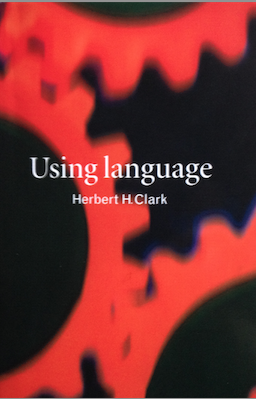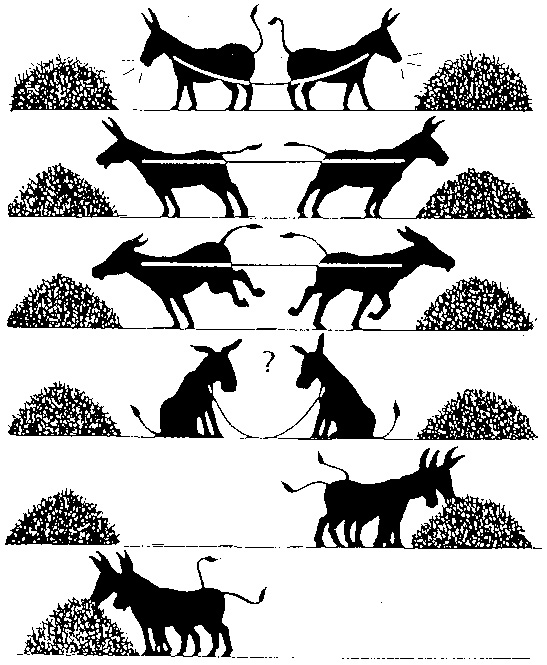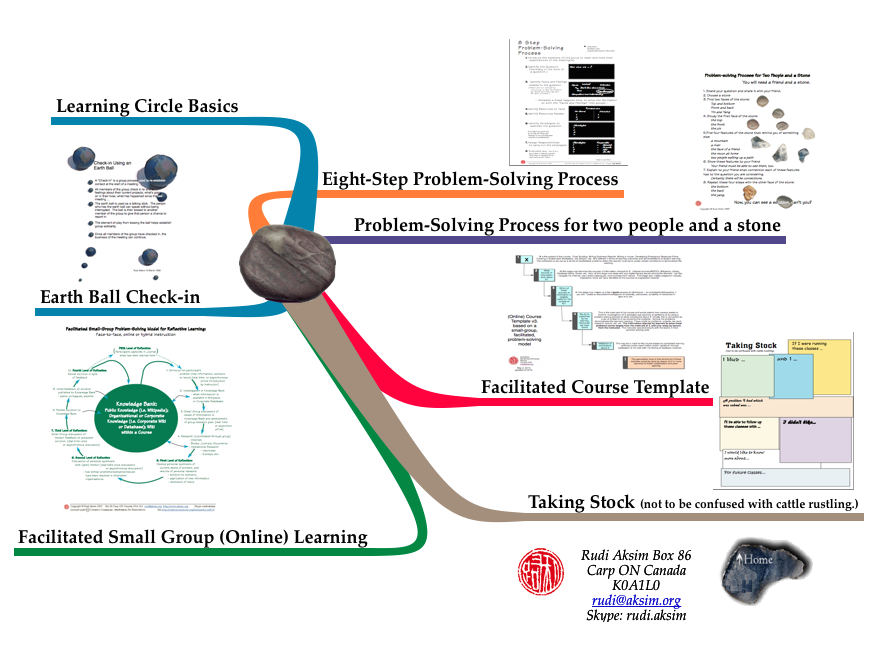Contents - Facilitation
- Facilitation - Conversation as a Way of Teaching
- Learning Circle Basics
- If you're exploring Learning Circles, you may want to read my story, A Systems Approach to Training, which is loosely based on a Learning Circle meeting.
- 8-Step Problem-Solving Process
- Problem-Solving Process for 2 people and a stone
- Earth Ball Check-in
- Taking Stock -- Not to be confused with Cattle Rustling. I don't know who developed this brilliant evaluation tool, but it is so much better than Rickert scale (i.e. 1_2_3_4_5_NA)!
- Facilitated Course Template
- Facilitated (Online) Course Model
Facilitation - Conversation as a Way of Teaching
Perhaps this is not the ideal place to launch a discussion of the important role facilitation can play in learning, but it seems to me that most teaching is conceived to be presentation by the teacher, which makes teachers into lecturers. A better way to look at teaching and learning, I think, is to regard it as a conversation between the teacher and the learners. There are many specific techniques one can learn and meeting processes one can use, but fundamentally, if you approach your teaching as a conversation rather than a presentation and then ask, what contributes to a good conversation, and then do that, you won't go wrong.
In this I have been much influenced by H.H. Clark, On Language. Clark proposes that conversations happen in "Common Ground", the place where the participants in a conversation meet. I think the teacher or facilitator's role is to create common ground for the other participants. We all have a common understanding of why we are here and what we are trying to accomplish. Many classes and presentations that I have seen go off the rails right from the start because the teacher fails effectively to establish common ground, often because he or she thinks there's no time to do that. But presumably there is time to teach a class in which learners don't learn much. One thinks about the old teacher joke summed up by this cartoon on Baldvin Georgsson's blog:

Following Clark you can think of the things that characterize a conversation and then seek to make those things happen in your classes. Clark talks about:

- Copresence (The participants share the same physical environment)
- Visibility (The participants can see each other)
- Audibility (The participants can hear each other)
- Instantaneity (The participants perceive each other's actions at no perceptible delay)
- Evanesence (The medium is evanescent: it fades quickly)
- Recordlessness (The participants' actions leave no record or artifact)
- Simultaneity (The participants can produce and receive at once and simultaneously)
And, of course, in a facilitated environment, the teacher and the learners are all "participants".
This presents particular problems for online learning, I think, for the very nature of the systems on which we offer online courses make it almost impossible to have a "conversation", because the communication is not evanescent, frequently not simultaneous and certainly always generate records. The perennial debate about participation on discussion boards is evidence of this, and I think Clark's presentation of conversation makes clear why online discussion is such a problem.
The challenge is to create an online course, I think, in which real conversation can happen. There are two suggestions here for an approach, the Facilitated Course Template, and the Facilitated (Online) Course Model. Of course, the key to this is not the structure of the course, but rather the processes that are used to deliver it. I do believe that a facilitated online course is possible, assuming that one uses groupwork in which the teacher doesn't meddle. If you are interested in my current musings on this subject, here is a recent mind-map, called "Conversation Space", albeit very incomplete and tentative. I'm glad to discuss this topic if you're interested.
Make your lecture into an exercise!
Another way of looking at this is not to ask yourself "What should I tell the learners?", but rather "When the learners have learned this, what will they be able to do? How will I know they have done a good job?" With that information you should be able to turn what you intended to tell them into an exercise in which they teach themselves. This is certainly more work than just standing at the front of the class and talking, but, I believe, it leads to much more actual learning. In this I am very influenced by my daughter's excellent Montessori teacher, Alison Goss, who was certainly one of the most gifted classroom managers I have ever seen.
What I'm often trying to do, as a facilitator, is to be one the the donkeys in this cartoon, which I first came across as a political poster from Allende's Chile. It now is on several American websites, apparently cleansed of its association with scary socialism:


Learning Circle Basics
A Learning Circle is a series of discussions, demonstrations, reports on readings and presentations through which the members of the Learning Circle share their knowledge and experience, learn new information and apply and test new skills.
It is a
- a small informal group that meets to study a subject or body of knowledge of interest to its members
- a way of structuring a series of small group meetings to draw on the knowledge and experience of a group of people

Why a Learning Circle?
- A Learning Circle makes learning more efficient, since reports, demonstrations and teaching experience are shared among the members of the circle.
- A Learning Circle provides an interactive learning situation. Teaching and training involve communication with people, and it is difficult to develop skills without a group of people to offer constructive criticism.
- A Learning Circle gives essential feedback to learners from colleagues who are working on the same body of skills and information, and whose suggestions on techniques and resources are hence particularly valuable.
- A Learning Circle offers the opportunity to organize demonstrations and workshops for which numbers of people are necessary.

How do Learning Circles work?
A group of people comes together to examine an issue or body of knowledge in which they are interested. After some initial planning, the group sets up a series of meetings (normally six to ten) with a specific (set of) goal(s) that the members of the group wish to accomplish through the meetings.
The study of a particular subject or skill usually involves a progression from definition of a subject, through study of the subject to demonstration by individual participants to a workshop involving a number of participants (and intended specifically to apply learning to members' on-going projects).

The Schedule of Learning Circle Meetings
The Learning Circle schedule is set by the group as a whole. It is created in a planning meeting and tells people when and where to come and what they should prepare
A schedule should be set up for a period of between six and ten meetings. This allows participants to plan their time effecitvely, but does not lock the Learning Circle into a rigid plan for the seemingly indefinite future

Types of Learning Circle Meetings
One way of lookg at the Learning Circle process is to identify different types of meetings that take place in the life of a Learning Circle:
- The Planning Meeting (in which a schedule is set up). You may wish to use the 8-step Problem-Solving Process as the stucture for your planning meeting.
- The Definition Session (in which a problem is defined for further exploration by general discussion)
- The Study Meeting (in which a problem is explored in some depth, perhaps through presentation(s) by participants in the Learning Circle)
- The Workshop (in which a number of participants come together to explore applications of what has been learned from other Learning Circle meetings )
- The Evaluation Meeting (in which the group evaluates a number of meetings and decides to continue with the Learning Circle and on any necessary course corrections)
Most Learning Circle meetings are a combination of definition and study of topics through discussion and presentation or demonstration by participants. Planning, at least for the next Learning Circle meeting, is an essential part of every meeting.

Roles in the Learning Circle Meeting
Ideally, all members participate in all meetings, and the engaged participant is the key member of the Learning Circle. In addition, participants play, on a rotational basis, the following three roles:
- Moderator (or chairperson)
- Recorder (or note-taker, assistant chairperson)
- Presenter (of a report or demonstration)
Moderator
The Moderator for a particular meeting has the responsibility of facilitating the meeting and keeping the discussion on track. In general this means that the moderator ensures that the agenda and the general meeting process (that has been agreed in advance) is followed.
- The moderator prepares the agenda and distributes it to participants and potential participants prior to the meeting and on a flip chart, whiteboard or projected image during the meeting. The agenda indicates the activity and the time planned for it.
- The moderator does not chair the meeting, in that remarks are not directed to the chair.
The role of moderator is there largely to see that the meeting stays on track, to remind people to stick to the agreed agenda and to see that the basic requirements for the different parts of the meeting are met.
Recorder
For most Learning Circles, the recorder is the person who will become the moderator at the next meeting. As the recorder, his or her responsibilites are to act as timekeeper and note-taker.
- As a timekeeper, the recorder lets the participants in the Learning Circle know if they fall more than ten minutes behind the times that have been agreed on the agenda.
- As the note-taker, the recorder is best informed to be the moderator at the next meeting.
Presenter
The presenter makes a short presentation, leads a demonstration or an activity in the Learning Circle meeting.
- A presenter may report, in outline, a concise summary of information. People may ask the presenter to fill in certain details after the report and he or she should be prepared to do this. The report itself should provide people with enough information to enable them to discuss the material and know where they need to know more.
- A presenter may demonstrate a technique or ask participants to engage in an activity, followed by "unpacking"-- that is a subsequent discussion of the activity
- A main purpose of presentation or demonstration is to ge feedback from participants in the follow-up discussion.

Tips
- Ideal size for a Learning Circle is between six and twelve participants
- A classroom is not an ideal setting for a Learning Circle -- you will want to sit around in a circle, not in rows.
- Have a common record of the meeting progress that everyone can see: a flipchart, a whiteboard or a projected image.

